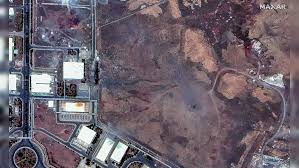Iran on Wednesday acknowledged for the first time that its nuclear facilities suffered significant damage during recent U.S. airstrikes, as questions continue to mount over the extent to which the attacks affected the country’s atomic program.
“Our nuclear installations have been badly damaged, that’s for sure,” said Iranian Foreign Ministry spokesperson Esmail Baghaei in an interview with Al Jazeera, as quoted by Bloomberg. While Baghaei did not disclose specific details, he stated that assessments were ongoing to determine the full scale of the damage. He also described the U.S. strikes as a “detrimental blow” to international law and the Nuclear Non-Proliferation Treaty, to which Iran is a signatory.
The comments mark the first public admission by Tehran following the June 22 U.S. assault on three nuclear sites in Iran, where more than a dozen 30,000-pound bombs were reportedly used in the strikes.
The remarks came shortly after U.S. President Donald Trump dismissed reports from his own intelligence community that suggested the bombings had a limited effect on Iran’s underground nuclear infrastructure. A Pentagon assessment by the Defense Intelligence Agency (DIA) reportedly concluded that the core components of Iran’s nuclear program, including centrifuges stored underground, remained largely intact.
Responding to the intelligence report during a NATO summit in The Hague, Trump said the findings were “very inconclusive,” but maintained that the damage was likely extensive. “It could have been very severe. That’s what the intelligence says. So I guess that’s correct, but I think we can take that we don’t know. It was very severe. It was obliteration,” he told reporters.
International Atomic Energy Agency (IAEA) Director General Rafael Grossi said preliminary information indicated “very significant damage” at Fordow, Iran’s main uranium enrichment site located beneath a mountain. However, the IAEA has not had access to Iranian facilities since Israeli strikes began on June 13.
Satellite imagery analyzed by experts in Vienna suggested that U.S. forces intentionally avoided hitting nuclear reactors at Iran’s Isfahan research facility, indicating a targeted strike to minimize radioactive fallout, according to four senior officials.
The Israel Atomic Energy Commission also weighed in, stating that the joint U.S.-Israeli attacks had rendered the Fordow enrichment facility inoperable and had set back Iran’s nuclear weapons development by “many years.”
Meanwhile, a ceasefire brokered by President Trump to end the 12-day conflict between Israel and Iran appeared to be holding as of Wednesday. Despite having criticized both countries earlier in the week—particularly Israel—for alleged early violations of the truce, Trump said both sides had agreed to uphold the ceasefire on the condition of mutual compliance.









